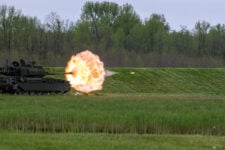
Soldiers assigned to the 14th Field Artillery Regiment, 75th Field Artillery Brigade fire rockets out of an M142 High Mobility Artillery Rocket System during a media engagement on camp Tapa, Estonia (US Army)
BELFAST — A collection of 600 bunkers are to be built across the borders of Estonia, Latvia and Lithuania to shore up NATO’s eastern flank and deliver a groundbreaking anti-mobility defensive line aimed at preventing any “quick and far-reaching offensive” launched by Russia.
Based on an agreement between the three Baltic countries last month and aligned to NATO’s new regional defense plans, the estimated €60 million ($65 million) anti-mobility installation project will see a first bunker constructed 2025.
The nations are “already halfway through [the] planning cycle, development and testing of product type bunkers,” said Susan Lilleväli, Estonia’s Undersecretary for Defence Readiness, during a press briefing today.
“We have seen different estimates [around] how quickly Russia can rebuild its military, and we need to use this time wisely,” she said. “We’ve come to conclusion that time to make all the necessary preparations [against an attack] is now.”

A map of the proposed bunker system presented by Estonian officials on Feb. 8, 2024 as defense against Russian invasion. (Screengrab)
Lilleväli’s warning comes on the heels of Kaja Kallas, Estonia’s prime minister, claiming that NATO has around three to five years to prepare for a war with Russia.
The new bunkers, similar to “underground cellars” commonly found in Estonia, are expected to be 35 square metres (377 square feet), hardened to withstand artillery strikes and house up to 10 soldiers. Supporting storage areas are set to be filled with non-explosive ordnance.
“We are not using or [stockpiling] any explosives or EOD [Explosive Ordnance Device] in peacetime, but they are pre-stocked closely enough to the defensive line,” said Lilleväli.
Next steps of planning and development include the construction of prototype bunkers for testing this year and decisions about the exact locations for the installations. Agreements for the specific position of the sites will depend on future negotiations with private landowners.
“The installations should start” in 2025, said Lilleväli.
Reserves Lt. Col. Kaido Tiitus, advisor to Estonia’s Undersecretary for Defence Readiness, said that warfighting lessons in Ukraine had demonstrated Baltic states “need to find ways” to stop “advances of Russian armored units,” adding that “if we let them run, we might be too late to protect our countries.”
He said that a “risk” can be taken when considering how the bunkers will withstand enemy fire because “larger” land based systems besides 120mm mortars and 152mm artillery shells carried by Russian howitzers will “mostly” look to strike aerial targets.
All three of the anti-mobility defensive line signatories also signed a Letter of Intent for procurement of US made M142 High Mobility Artillery Rocket System (HIMARS) equipment last month “aiming to create a framework for the joint use of the weapon system in both peace and wartime,” according to an Estonian Ministry of Defence statement.
Corrected 2/10/24 at 7:52 PM to correct conversion from meters to feet.
Aloha: Fixes ongoing, then Army’s new watercraft prototype is Hawaii bound for testing
“Everything that we can knock off that list we will do in the archipelago…because that allows us to do the tests in the environment that the vessel will operate in ultimately,” said Maj. Gen. Jered Helwig.


























